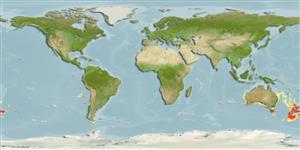>
Gonorynchiformes (Milkfishes) >
Gonorynchidae (Beaked salmons)
Etymology: Gonorynchus: Greek, gonia (γονια) = angle, corner + Greek, rhyngchos (or rhúnkhos - ῥύγχος) = snout (Ref. 45335).
More on author: Ogilby.
Environment: milieu / climate zone / depth range / distribution range
Ecología
marino demersal; oceanodromo (Ref. 48492); rango de profundidad 104 - 1233 m (Ref. 48492). Subtropical; 11°S - 58°S
Southwest Pacific. New Zealand and New Caledonia. Distribution crosses three broad climate zones (subtropical, temperate, and subantarctic) and two biogeographic/hydrographic barriers (tropical and subtropical convergence zones).
Tamaño / Peso / Age
Maturity: Lm ? range ? - ? cm
Max length : 48.6 cm SL macho / no sexado; (Ref. 38037)
Radios blandos dorsales (total) : 10 - 11; Radios blandos anales: 7 - 8; Vértebra: 64 - 66. Pigmented brown dorsally and orange-pink ventrally; fins have dark gray patches contrasting with pale gray patches at the margins. Lower lip of mouth with elongated forked papillae. Lateral line pore tubes positioned between every 2 scales instead of the common pattern of 2:1:2 (Ref. 38037). Caudal vertebrae (= pleural caudal vertebrae + ural caudal vertebrae) 12 + 1. Lateral line scale pattern of 2:2:2 (that is, 2 scales: pore, 2 scales: pore, etc.)
Inhabits coastal sandy habitats , bays and estuaries where they remain buried during the day. Also found in deeper water 160-678 m. Juvenile, subadult and adult occur in shallow coastal areas; adults also inhabit deep shelf and slope areas and isolated offshore plateaus, and are capable of moving between the two (Ref. 48492). With the first New Caledonian record based on one ripe female and one spent male, captured at 960-1233 m depth, over 700 nautical miles from the nearest known populations, it is hypothesized that adult sandfish migrates along oceanic ridges to spawn in southern New Caledonian waters (Ref. 48492).
Life cycle and mating behavior
Maturities | Reproducción | Spawnings | Egg(s) | Fecundities | Larva
Grande, T., 1999. Revision of the genus Gonorynchus Scopoli, 1777 (Teleostei: Ostariophysi). Copeia 1999(2):453-469. (Ref. 38037)
IUCN Red List Status (Ref. 130435)
Threat to humans
Harmless
Human uses
Herramientas
Special reports
Download XML
Fuentes de Internet
Estimates based on models
Preferred temperature (Ref.
123201): 7.6 - 14.3, mean 9.5 °C (based on 134 cells).
Phylogenetic diversity index (Ref.
82804): PD
50 = 0.5625 [Uniqueness, from 0.5 = low to 2.0 = high].
Bayesian length-weight: a=0.00389 (0.00180 - 0.00842), b=3.12 (2.94 - 3.30), in cm total length, based on all LWR estimates for this body shape (Ref.
93245).
Nivel trófico (Ref.
69278): 2.0 ±0.1 se; based on size and trophs of closest relatives
Fishing Vulnerability (Ref.
59153): Moderate vulnerability (44 of 100).
